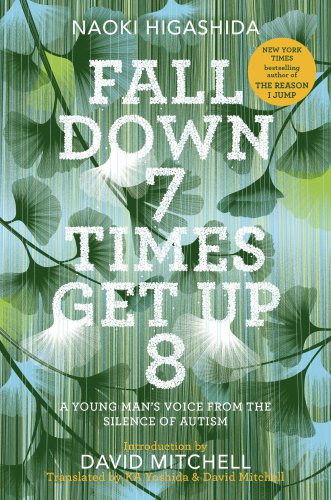
Fall Down 7 Times Get Up 8
A Young Man's Voice from the Silence of Autism
کتاب های مرتبط
- اطلاعات
- نقد و بررسی
- دیدگاه کاربران
نقد و بررسی

May 22, 2017
An outwardly wordless consciousness blossoms into expressive prose in this vibrant, if uneven, self-portrait. Higashida is a nonverbal, severely autistic 24-year-old Japanese man who cannot hold a conversation but has learned to write by pointing at and voicing letters on an alphabetic grid and by using a computer. (The author’s 2007 memoir, The Reason I Jump, was an international bestseller.) This latest collection of his writings features short essays, interviews, poems, and a lyrical, dreamlike short story. He includes somewhat generic thoughts on topics ranging from war to God, but he focuses largely on his life as an autistic person. It’s a life of obsessive routines, rituals, and literalism: the slightest change in plans throws him into a state of extreme agitation, activities must start and stop at prescheduled times, searching out Hello Kitty souvenirs calms his anxiety in unfamiliar train stations, having his photo taken causes him to fixate on the trivial differences between individual cameras. In Mitchell and Yoshida’s deft translation, Higashida conveys this isolating mind-set and his yearnings for connection and self-expression, in direct, evocative prose—his compulsive, restless motion, he writes, is “instinctual, like a wild animal running over a wide plain”—that provides readers with a window into a previously unknowable world. Photos. Agent: Douglas Stewart, Sterling Lord.

May 15, 2017
A young Japanese man's searching account of autism, following The Reason I Jump: The Inner Voice of a Thirteen-Year-Old Boy with Autism (2013).Higashida, now 24, lives in silence. He cannot speak, but though his condition is of a kind categorized as both nonverbal and severe, he has learned to communicate by way of a keyboard that renders hiragana characters out of Roman letters. As co-translator Mitchell, a noted English novelist whose own son is autistic, writes, it is an arduous way of communicating. He adds, "Naoki's autism bombards him with distractions and prompts him to get up mid-sentence, pace the room and gaze out the window." That we have this illuminating book at all is a testament of his extraordinary effort, but there is little by way of self-pity to mark it. Higashida writes with confidence about his many interests, including nature and mathematics, and "the immutable beauties of autism," and he reckons himself lucky to be wired as he is. People with his condition, he writes, do not seek pity from outsiders, either, but instead the chance to live outside the confines of shunted-off institutions and as independently as possible. "Yes," he writes, "the neurotypical majority might be more productive than us, but we, too, want to embrace life and be of use to others as best we can." What people with special needs want and require more than anything else is the same search for meaning that any other person of free will conducts. In a mix of short essays--including the opener, a lovely thank-you note to a mother to whom he has never spoken--Higashida explores aspects of his atypicality, most of it pointing to the fact that he is indeed atypical, indeed unlike most other people, in the depth of his emotional and intellectual strength. Autism is a mysterious neurological condition. While the science is incomplete, Higashida gives us a thoughtful view of the art of living well in its shadow.
COPYRIGHT(2017) Kirkus Reviews, ALL RIGHTS RESERVED.

June 1, 2017
Now 24, Higashida shares his experiences living with severe, nonverbal autism since he wrote his first, celebrated memoir, The Reason I Jump (2013). His translators, Yoshida and the best-selling novelist Mitchell (Slade House, 2015), are parents to an 11-year-old son with nonverbal autism. Mitchell is fascinated by Higashida's empathy and emotional range, what people with autism are famous for lacking, he writes in his powerful introduction. Society mistakes the inability to speak normally with the inability to think normally, Mitchell observes. It's a severe sensory-processing and communicative impairment . . . To deny that a severely autistic brain may house a mind as curious and imaginative as anyone else's is to perpetuate a ruinous falsehood. Higashida shares blog posts and an interview and encourages readers to think about the world in a different way. I'm fascinated by some things that other people have no interest in whatsoever, he says. Readers open to the benefits of differences, including neurodiversity, will feel grateful that Higashida can use a typewriter-like alphabet grid to communicate and share his inner life in this can-do memoir.(Reprinted with permission of Booklist, copyright 2017, American Library Association.)

March 1, 2017
At age 13, Higashida wrote The Reason I Jump, an international phenomenon that offered an extraordinary look into the mind of a child with autism. This new memoir finds the author moving into young adulthood and wrestling with issues of identity, family, and society, creating the portrait of a unique individual, not just a labeled type.
Copyright 2017 Library Journal, LLC Used with permission.

























دیدگاه کاربران